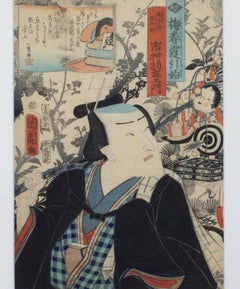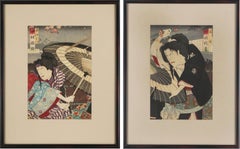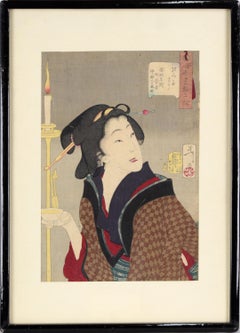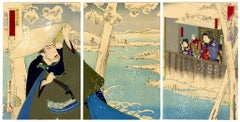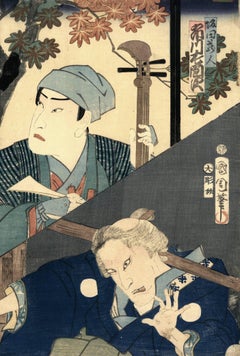Toyoharu Kunichika Prints and Multiples
to
1
Overall Width
to
Overall Height
to
1
1,162
893
893
803
1
1
1
1
1
1
1
1
Artist: Toyoharu Kunichika
19th century color woodcut Japanese ukiyo-e print samurai figure
By Toyoharu Kunichika
Located in Milwaukee, WI
"Ichimura Hazaemon as Hatsuyumeya Mitsujiro" is a woodcut print by Toyoharu Kunichika in red, blue, and black.
14" x 9 1/2" art
20 3/4" x 16 3/4" framed
From the series “First Per...
Category
1860s Edo Toyoharu Kunichika Prints and Multiples
Materials
Woodcut
Related Items
Japanese Figurative Edo Woodblock Set of Two
By Toyohara Kunichika
Located in Soquel, CA
Alluring two-piece edo woodblock print of Japanese actors by Toyohara Kunichika (Japanese, 1835-1900). Titled, dated and signed on verso. Presented...
Category
1880s Edo Toyoharu Kunichika Prints and Multiples
Materials
Paper, Ink, Woodcut
"Thirsty: the appearance of a town geisha in the Ansei era" - Woodblock on Paper
By Tsukioka Yoshitoshi
Located in Soquel, CA
"Thirsty: the appearance of a town geisha in the Ansei era" - Woodblock on Paper
From the series "Thirty-two Aspects of Customs and Manners" (Fuzoku sanjuniso)
Lively woodblock of a...
Category
1880s Edo Toyoharu Kunichika Prints and Multiples
Materials
Paper, Ink, Woodcut
$760 Sale Price
20% Off
H 20 in W 14 in D 0.75 in
Two Kabuki Actors Japanese Woodblock Print
By Toyohara Kunichika
Located in Houston, TX
Two kabuki actors posing a samurai's. The print is printed on rice paper and is not framed. It is stamped by the artist with details about the actors in ...
Category
1860s Edo Toyoharu Kunichika Prints and Multiples
Materials
Woodcut
Japanese Beauties Enjoy a Full Moon
By Utagawa Kunisada (Toyokuni III)
Located in Burbank, CA
"Sun, Moon and Stars". Three beauties enjoy a full moon on the veranda of a teahouse or restuarant. The woman on the left kneels and adjusts her lavishly printed kimono. The beauty in the center has her hair down, and behind her is a screen against which shadows are beautifully silhouetted, which adds an air of mystery. The seated woman on the right is perhaps a geisha, as we see a shamisen lying next to her. Before her is a tray with an assortment of foods. One may surmise that the beauties are being compared to the sun, the moon, and the stars. On the left we glimpse a full moon shining over the peaceful bay, and boats at harbor. Original first edition Japanese color woodblock print triptych...
Category
1840s Edo Toyoharu Kunichika Prints and Multiples
Materials
Mulberry Paper, Woodcut
$3,600
H 14.18 in W 29.06 in
One Hundred Aspects of the Moon, Mt Otawa Moon - Bright God Tamura
By Tsukioka Yoshitoshi
Located in Soquel, CA
"Mount Otawa Moon: Bright God Tamura" - Woodblock on Paper by Tsukioka Yoshitoshi
From the series "One Hundred Aspects of the Moon"
This piece depicts the general Sakanoe no Tamura...
Category
1880s Edo Toyoharu Kunichika Prints and Multiples
Materials
Paper, Ink, Woodcut
$487 Sale Price
35% Off
H 20.5 in W 15.5 in D 0.75 in
Kabuki Actor Diptych, Late 19th Century Figural Japanese Woodblock Prints (Pair)
By Kunichika Toyohara
Located in Soquel, CA
Beautiful late 19th century Japanese woodblock print diptych of two kabuki actors by Kunichika Toyohara (Japanese, 1835-1900). This pair of prints is united by a continuous landscape...
Category
1870s Edo Toyoharu Kunichika Prints and Multiples
Materials
Paper, Ink, Woodcut
$875
H 21.63 in W 35 in D 1 in
Japanese Original Woodblock Print
Located in Soquel, CA
Japanese Original Woodblock Print
Harunobu Suzuki (né Hozumi) (Japanese, 1724 - 1770)
Presented in a black mat.
Mat: 16"H x 12"W
Paper: 12"H x 9"W
I...
Category
18th Century Edo Toyoharu Kunichika Prints and Multiples
Materials
Ink, Rice Paper, Woodcut
The Battle of Dan-no-ura in Yashima, Nagato Province in the First Year .....
By Utagawa Yoshitora
Located in Middletown, NY
The Battle of Dan-no-ura in Yashima, Nagato Province in the First Year of the Bunji Era (1185)
Tokyo c. 1830
Woodblock print (nishiki-e) with ink and hand-coloring in watercolor on handmade mulberry paper, 14 7/16 x 9 15/16 inches (367 x 252 mm), ōban tate-e, the full sheet. In good condition with some handling creases. Colors are fresh and extremely vibrant. The right panel from the triptych by Yoshitora depicting one of Japan's most storied naval battles. An impression of this work may be found in the permanent collection of the Honolulu Museum of Art.
The great naval battle of Dan-no-ura in 1185 was the final climax in a long series of bitter wars between two powerful families in feudal Japan...
Category
Early 19th Century Edo Toyoharu Kunichika Prints and Multiples
Materials
Watercolor, Handmade Paper, Woodcut
$1,500
H 14.44 in W 9.94 in
Mitate of a Daimyo's Procession Crossing Ryogoku Bridge - Woodblock Print
By Keisai Eisen
Located in Soquel, CA
Mitate of a Daimyo's Procession Crossing Ryogoku Bridge - Woodblock Print
Woodblock print of a procession by Keisai Eisen (Japanese, 1790–1848). Terrific triptych of a procession of...
Category
Early 19th Century Edo Toyoharu Kunichika Prints and Multiples
Materials
Ink, Rice Paper, Woodcut
$1,320 Sale Price
20% Off
H 24 in W 36 in D 0.25 in
Kiyomizu Temple, Scenes of Famous Places along Tôkaidô Road - Woodblock on Paper
By Utagawa Hiroshige II
Located in Soquel, CA
Kiyomizu Temple, Scenes of Famous Places along Tôkaidô Road - Woodblock on Paper
Full Title:
Kyoto: Kiyomizu Temple (Kyô Kiyomizudera), from the series Scenes of Famous Places along...
Category
1860s Edo Toyoharu Kunichika Prints and Multiples
Materials
Ink, Rice Paper, Woodcut
$960 Sale Price
20% Off
H 20 in W 16 in D 0.25 in
Edo Landscape Japanese Woodblock Print
By Utagawa Hiroshige (Ando Hiroshige)
Located in Houston, TX
Edo Meisho woodblock print of a famous Japanese coastal dock. This woodblock is most likely apart of the series "One Hundred Famous Views of Edo." The woodblock print is printed on r...
Category
1850s Edo Toyoharu Kunichika Prints and Multiples
Materials
Woodcut
$1,500
H 10 in W 15 in D 0.004 in
Bijin-ga Woman Kneeling by River Japanese Print
By Kuniyasu
Located in Houston, TX
Japanese woodblock print of a woman kneeling by the river. She is holding a stick making it appear like she is fishing with it. The woodblock print is printed on rice paper. The print is not framed.
Artist Biography: Utagawa Kuniyasu...
Category
1830s Edo Toyoharu Kunichika Prints and Multiples
Materials
Woodcut
Previously Available Items
Farewell at Iwahashi Village - Kabuki
By Toyoharu Kunichika
Located in Fairlawn, OH
Medium: Color woodcut
Date Of Execution: 1884
Dimensions: Left: 14 1/8 x 9 1/2"; Center: 14 1/8 x 9 3/8"; Right: 14 1/8 x 9 1/8"
Signature: Signature: Toyohara Kunichika; Seal: Toshi...
Category
1880s Other Art Style Toyoharu Kunichika Prints and Multiples
Materials
Woodcut
Kabuki Actors: Ichikawa and Iwai.
By Toyoharu Kunichika
Located in Storrs, CT
14 x 9 1/2 (sheet 14 x 3/4). Good color and condition. Soiling in the bottom right-hand; slight toning. Signed and sealed 'Kunichika hitsu'.
Housed in a 20 x 16 inch archival mat, suitable for framng.
Born in 1835, Toyohara Kunichika grew up in the Kyobashi district of Edo in the midst of merchants and artisans. In 1848, at age 13, he was accepted as an apprentice into the studio of Utagawa Kunisada I...
Category
Mid-19th Century Edo Toyoharu Kunichika Prints and Multiples
Materials
Color, Woodcut
Actors in a Kabuki Play.
By Toyoharu Kunichika
Located in Storrs, CT
Actors in a Kabuki Play. 1865.The actors are, left to right, Kinokuniya Bunzaemon, Suberoku, Miura Akemaki. 1865. Vertical oban. Each sheet 13 3/4 x 9 1/2 (total measurements 13 3/4 x 28 1/16). Paper losses at sheet edges, not affecting the main image. Fine color and condition. Signed and sealed 'Kunichika hitsu'
Ex-collection Ulfert Wilke...
Category
1860s Edo Toyoharu Kunichika Prints and Multiples
Materials
Color, Woodcut
Kabuki Actors
By Toyoharu Kunichika
Located in Storrs, CT
Kabuki Actors. c. 1864. Oban diptych (14 1/8 x 18 3/4). 2 small repairs in the top margin, 1 foxing spot in the right-hand actor's face; otherwise good c...
Category
Mid-19th Century Edo Toyoharu Kunichika Prints and Multiples
Materials
Woodcut
Kabuki Actors Iwai and Ichikawa
By Toyoharu Kunichika
Located in Storrs, CT
Kabuki Actors Iwai and Ichikawa 1864. Oban diptych (14 1/8 x 19 1/4. Good color and condition. The print is not laid down. The sheets are not joined tog...
Category
Mid-19th Century Edo Toyoharu Kunichika Prints and Multiples
Materials
Color, Woodcut
Toyoharu Kunichika prints and multiples for sale on 1stDibs.
Find a wide variety of authentic Toyoharu Kunichika prints and multiples available for sale on 1stDibs. Not every interior allows for large Toyoharu Kunichika prints and multiples, so small editions measuring 17 inches across are available. Customers who are interested in this artist might also find the work of Utagawa Hiroshige (Ando Hiroshige), Utagawa Kunisada (Toyokuni III), and Kunichika Toyohara. Toyoharu Kunichika prints and multiples prices can differ depending upon medium, time period and other attributes. On 1stDibs, the price for these items starts at $3,000 and tops out at $3,000, while the average work can sell for $3,000.
